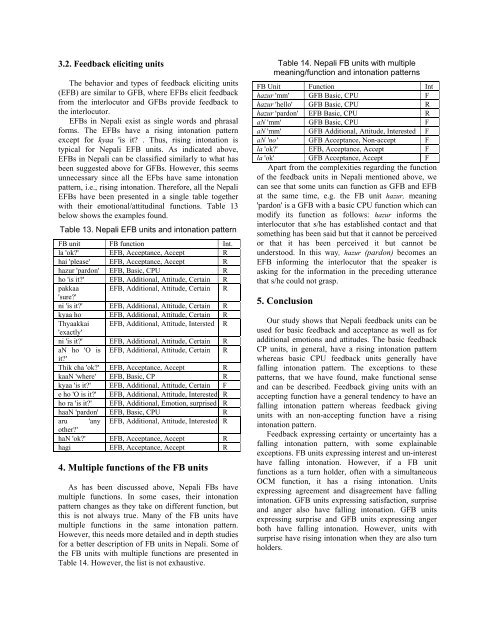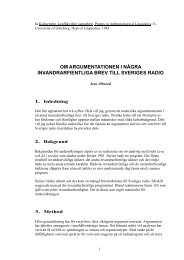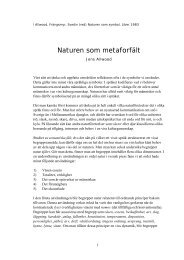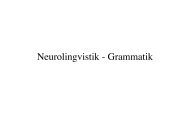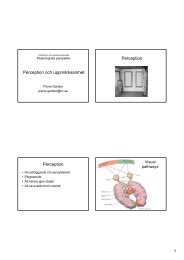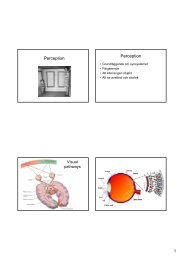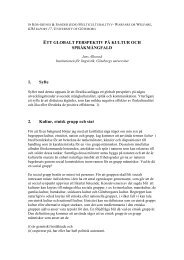Intonation Patterns in Nepali Feedback Units
Intonation Patterns in Nepali Feedback Units
Intonation Patterns in Nepali Feedback Units
Create successful ePaper yourself
Turn your PDF publications into a flip-book with our unique Google optimized e-Paper software.
3.2. <strong>Feedback</strong> elicit<strong>in</strong>g units<br />
The behavior and types of feedback elicit<strong>in</strong>g units<br />
(EFB) are similar to GFB, where EFBs elicit feedback<br />
from the <strong>in</strong>terlocutor and GFBs provide feedback to<br />
the <strong>in</strong>terlocutor.<br />
EFBs <strong>in</strong> <strong>Nepali</strong> exist as s<strong>in</strong>gle words and phrasal<br />
forms. The EFBs have a ris<strong>in</strong>g <strong>in</strong>tonation pattern<br />
except for kyaa 'is it? . Thus, ris<strong>in</strong>g <strong>in</strong>tonation is<br />
typical for <strong>Nepali</strong> EFB units. As <strong>in</strong>dicated above,<br />
EFBs <strong>in</strong> <strong>Nepali</strong> can be classified similarly to what has<br />
been suggested above for GFBs. However, this seems<br />
unnecessary s<strong>in</strong>ce all the EFbs have same <strong>in</strong>tonation<br />
pattern, i.e., ris<strong>in</strong>g <strong>in</strong>tonation. Therefore, all the <strong>Nepali</strong><br />
EFBs have been presented <strong>in</strong> a s<strong>in</strong>gle table together<br />
with their emotional/attitud<strong>in</strong>al functions. Table 13<br />
below shows the examples found.<br />
Table 13. <strong>Nepali</strong> EFB units and <strong>in</strong>tonation pattern<br />
FB unit FB function Int.<br />
la 'ok?' EFB, Acceptance, Accept R<br />
hai 'please' EFB, Acceptance, Accept R<br />
hazur 'pardon' EFB, Basic, CPU R<br />
ho 'is it?' EFB, Additional, Attitude, Certa<strong>in</strong> R<br />
pakkaa<br />
'sure?'<br />
EFB, Additional, Attitude, Certa<strong>in</strong> R<br />
ni 'is it?' EFB, Additional, Attitude, Certa<strong>in</strong> R<br />
kyaa ho EFB, Additional, Attitude, Certa<strong>in</strong> R<br />
Thyaakkai<br />
'exactly'<br />
EFB, Additional, Attitude, Intersted R<br />
ni 'is it?' EFB, Additional, Attitude, Certa<strong>in</strong> R<br />
aN ho 'O is EFB, Additional, Attitude, Certa<strong>in</strong> R<br />
it?'<br />
Thik cha 'ok?' EFB, Acceptance, Accept R<br />
kaaN 'where' EFB, Basic, CP R<br />
kyaa 'is it?' EFB, Additional, Attitude, Certa<strong>in</strong> F<br />
e ho 'O is it?' EFB, Additional, Attitude, Interested R<br />
ho ra 'is it?' EFB, Additional, Emotion, surprised R<br />
haaN 'pardon' EFB, Basic, CPU R<br />
aru 'any EFB, Additional, Attitude, Interested R<br />
other?'<br />
haN 'ok?' EFB, Acceptance, Accept R<br />
hagi EFB, Acceptance, Accept R<br />
4. Multiple functions of the FB units<br />
As has been discussed above, <strong>Nepali</strong> FBs have<br />
multiple functions. In some cases, their <strong>in</strong>tonation<br />
pattern changes as they take on different function, but<br />
this is not always true. Many of the FB units have<br />
multiple functions <strong>in</strong> the same <strong>in</strong>tonation pattern.<br />
However, this needs more detailed and <strong>in</strong> depth studies<br />
for a better description of FB units <strong>in</strong> <strong>Nepali</strong>. Some of<br />
the FB units with multiple functions are presented <strong>in</strong><br />
Table 14. However, the list is not exhaustive.<br />
Table 14. <strong>Nepali</strong> FB units with multiple<br />
mean<strong>in</strong>g/function and <strong>in</strong>tonation patterns<br />
FB Unit Function Int<br />
hazur 'mm' GFB Basic, CPU F<br />
hazur 'hello' GFB Basic, CPU R<br />
hazur 'pardon' EFB Basic, CPU R<br />
aN 'mm' GFB Basic, CPU F<br />
aN 'mm' GFB Additional, Attitude, Interested F<br />
aN 'no' GFB Acceptance, Non-accept F<br />
la 'ok?' EFB, Acceptance, Accept F<br />
la 'ok' GFB Acceptance, Accept F<br />
Apart from the complexities regard<strong>in</strong>g the function<br />
of the feedback units <strong>in</strong> <strong>Nepali</strong> mentioned above, we<br />
can see that some units can function as GFB and EFB<br />
at the same time, e.g. the FB unit hazur, mean<strong>in</strong>g<br />
'pardon' is a GFB with a basic CPU function which can<br />
modify its function as follows: hazur <strong>in</strong>forms the<br />
<strong>in</strong>terlocutor that s/he has established contact and that<br />
someth<strong>in</strong>g has been said but that it cannot be perceived<br />
or that it has been perceived it but cannot be<br />
understood. In this way, hazur (pardon) becomes an<br />
EFB <strong>in</strong>form<strong>in</strong>g the <strong>in</strong>terlocutor that the speaker is<br />
ask<strong>in</strong>g for the <strong>in</strong>formation <strong>in</strong> the preced<strong>in</strong>g utterance<br />
that s/he could not grasp.<br />
5. Conclusion<br />
Our study shows that <strong>Nepali</strong> feedback units can be<br />
used for basic feedback and acceptance as well as for<br />
additional emotions and attitudes. The basic feedback<br />
CP units, <strong>in</strong> general, have a ris<strong>in</strong>g <strong>in</strong>tonation pattern<br />
whereas basic CPU feedback units generally have<br />
fall<strong>in</strong>g <strong>in</strong>tonation pattern. The exceptions to these<br />
patterns, that we have found, make functional sense<br />
and can be described. <strong>Feedback</strong> giv<strong>in</strong>g units with an<br />
accept<strong>in</strong>g function have a general tendency to have an<br />
fall<strong>in</strong>g <strong>in</strong>tonation pattern whereas feedback giv<strong>in</strong>g<br />
units with an non-accept<strong>in</strong>g function have a ris<strong>in</strong>g<br />
<strong>in</strong>tonation pattern.<br />
<strong>Feedback</strong> express<strong>in</strong>g certa<strong>in</strong>ty or uncerta<strong>in</strong>ty has a<br />
fall<strong>in</strong>g <strong>in</strong>tonation pattern, with some expla<strong>in</strong>able<br />
exceptions. FB units express<strong>in</strong>g <strong>in</strong>terest and un-<strong>in</strong>terest<br />
have fall<strong>in</strong>g <strong>in</strong>tonation. However, if a FB unit<br />
functions as a turn holder, often with a simultaneous<br />
OCM function, it has a ris<strong>in</strong>g <strong>in</strong>tonation. <strong>Units</strong><br />
express<strong>in</strong>g agreement and disagreement have fall<strong>in</strong>g<br />
<strong>in</strong>tonation. GFB units express<strong>in</strong>g satisfaction, surprise<br />
and anger also have fall<strong>in</strong>g <strong>in</strong>tonation. GFB units<br />
express<strong>in</strong>g surprise and GFB units express<strong>in</strong>g anger<br />
both have fall<strong>in</strong>g <strong>in</strong>tonation. However, units with<br />
surprise have ris<strong>in</strong>g <strong>in</strong>tonation when they are also turn<br />
holders.


